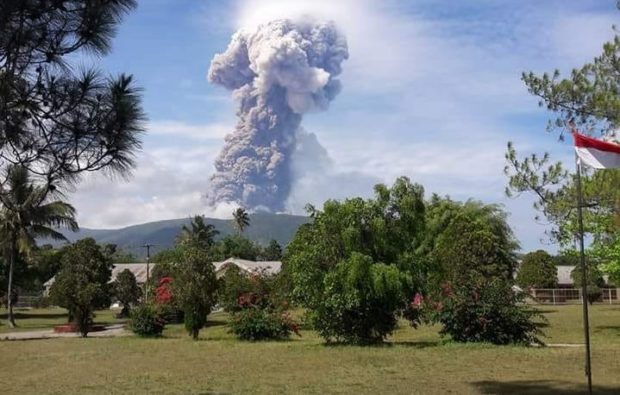Volcano erupts on same Indonesian island hit earlier by quake, tsunami

North Sulawesi’s Mount Soputan erupts at 8:47 a.m. on Oct. 3, spewing a column of ash into the skies above Minahasa regency. The Center for Volcanology and Geological Hazard Mitigation (CVGHM) has raised the volcano’s alert status to Level III (alert). (Courtesy of BNPB; The Jakarta Post/Asia News Network)
Published: 12:53 a.m., Oct. 3, 2018 | Updated: 9:37 p.m., Oct. 3, 2018
JAKARTA, Indonesia — A volcano erupted Wednesday on the same central Indonesian island struck last week by a powerful earthquake and tsunami, and authorities warned planes about volcanic ash in the air.
Mount Soputan on Sulawesi island spewed a massive column of ash more than 6,000 meters (19,700 feet) into the sky at around 8:47 a.m. local time, or 7:47 a.m. Jakarta time, prompting authorities to raise the volcano’s status to Level III (alert) of the four-level national volcano alert system.
No evacuations were immediately ordered.
Potential lava flows
But according to The Jakarta Post, the Center for Volcanology and Geological Hazard Mitigation (CVGHM) advised local residents to refrain from entering the area within a 4- to 6.5-kilometer radius around Mount Soputan.
Article continues after this advertisementResidents of riverbank settlements near the mountain – those on the Ranowangko, Lawian, Popang and Kelewahu rivers – were also warned of the potential for lava flows following rain.
Article continues after this advertisementThe CVGHM forecast that the volcanic ash was drifting to the west and northwest.
“This means that the volcanic ash will not disrupt flights. Sam Ratulangi International Airport in Manado is still operating normally, as it is located southeast of the mountain,” the center said in a statement, according to the The Jakarta Post.
“We also suggest residents to use dust masks to avoid any potential respiratory problems in the event of falling ash,” the center added.
The North Sulawesi Disaster Mitigation Agency (BPBD) has distributed masks to residents of the affected areas.
Butterfly effect?
According to The Associated Press, a government volcanologist said it’s possible the eruption was accelerated by the magnitude 7.5 earthquake that struck on Friday.
“It could be that this earthquake triggered the eruption, but we have seen an increase in volcanic activity since July and this began surging on Monday. Yet we can’t say there a direct link, as the mountain is quite far away,” Kasbani, the head of Indonesia’s Volcanology and Geology Disaster Mitigation Agency, said on local television.
Kasbani, who uses one name, said planes have been warned to avoid the area.
Nazli Ismail, a geophysicist at the University of Syiah Kuala in Banda Aceh on Sumatra island stressed there was no concrete evidence to show the two incidents are linked.
“People talk about the butterfly effect. The concept is that when a butterfly flaps its wings, it can cause a catastrophe,” he said. “So it is possible for the earthquake to trigger the volcano eruption, but it’s not conclusive. This needs to be further investigated.”
Danny Hillman Natawidjaja, a geologist with Indonesia’s Institute of Science, echoed the views, saying there was not enough data to make a link.
“In principle, the seismic waves from the earthquake could increase pressure in the volcano’s magma chamber and could cause an eruption. We don’t know for sure,” he said.
He cited the example of the eruption of Mount Talang volcano in Indonesia’s Sumatra province in April 2005, which geologists have said was connected to the devastating December 2004 Indian Ocean earthquake and tsunami.
Ismail said the Soputan volcano eruption isn’t surprising as Indonesia sits on the seismically active Pacific “Ring of Fire,” and Soputan is one of the most active volcanoes on the island.
Soputan’s eruption status was raised from an alert to standby 4 kilometers (2.5 miles) from the summit and up to 6.5 kilometers to the west-southwest. Standby status means the public should avoid the area nearest the volcano and have masks available in the event of ash fall.
Planes warned about ash
Planes were warned of the ash clouds because volcanic ash is hazardous for their engines.
National disaster agency spokesman Sutopo Purwo Nugroho dismissed concerns that the volcano’s eruption could affect planes transporting aid and supplies to the quake disaster areas.
The earthquake set off a tsunami and devastated several communities, with the official death toll rising Wednesday to 1,407 and expected to increase further. Thousands of others are injured and more than 70,000 have been displaced from their homes.
Nugroho said volcanic ash is not heading to the city of Palu, where most of the victims from the quake and tsunami are from, as the wind is blowing in another direction. He said it hasn’t disrupted plane services or affected any evacuations from the disaster areas.
Nugroho denounced videos that had appeared on social media allegedly showing villagers fleeing from billowing black smoke from the volcano and a long smoldering lava river as a hoax.
He said so far no lava has spewed out from Soputan. No injuries or deaths have been reported and there is no need for any evacuation at the moment, he added.
Indonesia is an archipelago of more than 250 million people and government seismologists monitor more than 120 active volcanoes. /atm